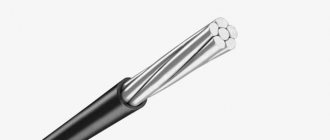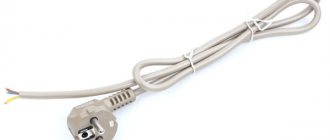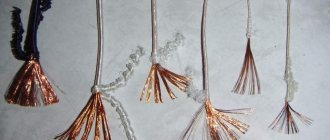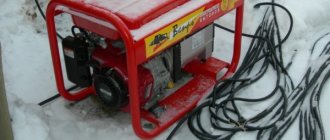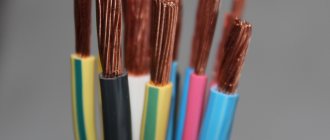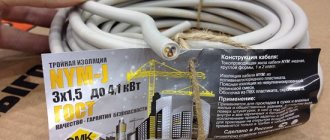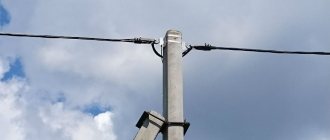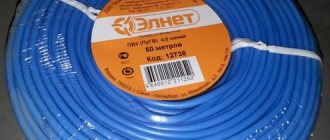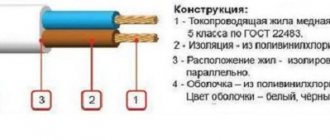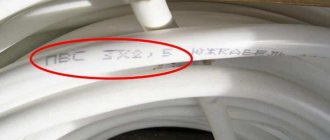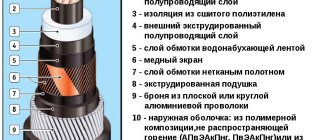General principles for marking cable products
In order to make it easier to identify the cable, its characteristics and scope of application, a cable identification or marking system was developed. Data is recorded in a specific order, each letter or number has its own meaning.
How to decipher cable markings
What each position means and what letters may appear there, see the table below. There's not much to add here:
| Arrangement of letters or numbers | What does it mean | Letters used and their decoding |
| 1st letter | Core material | - no letter - copper |
| A - aluminum | ||
| 2nd letter | Degree of flexibility | G - flexible, stranded |
| there is nothing - single-core | ||
| 3rd letter | Insulation material | B - polyvinyl chloride (PVC) |
| P - polyethylene | ||
| R - rubber | ||
| HP - non-flammable week | ||
| F - fluoroplastic | ||
| C - film insulation (for installation wires) | ||
| 4th letter | Shell material or armor type | BBG - armor made of steel profiled tape |
| BN - armor made of steel strips with a protective coating that does not support combustion | ||
| B - PVC | ||
| D - double wire braid | ||
| K - armor made of round steel wires enclosed in a steel cover | ||
| SB - lead armor | ||
| 5th letter | Type of protective cover, purpose of the outer layer, designation of the core design | B - PVC (if it appears at the end it means paper insulation) |
| G - anti-corrosion protective layer. If “G” - no protection against mechanical damage | ||
| O - insulated wires are united by a common braid | ||
| Seam - protective layer - pressed PVC hose | ||
| Shp - protective layer - pressed polyethylene hose | ||
| Shps - too, but self-extinguishing polytilene | ||
| E - shielded | ||
| T - wire for laying in pipes |
Also, the cable marking consists of several numbers. There may be an operating voltage (for power cables), then the number of cores is required and the cross-section of these cores is indicated through the “x” sign. And the last thing that can be applied is the designation of the standard according to which this type of cable and wire product is manufactured.
any brand of cable can be deciphered using the diagram
- A - (first letter) - aluminum core;
- A - (second letter) - aluminum shell;
- (A) - the cable has the index “flame retardant according to category A”
- B - armored cover made of flat strips;
- b - absence of a cushion from the protective cover;
- B - PVC sheath (first letter) or core insulation (second letter) when located at the beginning or in the middle of the brand designation;
- In with a hyphen at the end of the designation - depleted insulation;
- in the middle of the designation - insulation made of vulcanized polyethylene;
- at the end of the designation there is a protective cover cushion with a polyvinyl chloride hose;
- G - absence of outer cover over armor or metal shell;
- K - armored cover made of round steel wires;
- l - reinforced cushion made of protective cover;
- 2l - especially reinforced cushion made of protective cover;
- N - rubber oil-resistant shell, non-flammable;
- n - non-flammable outer cover of the protective cover;
- O - a separate shell of each core;
- P - at the beginning or middle of the designation - polyethylene sheath or core insulation;
- P - at the end of the designation - armored cover made of flat steel wires;
- p - pillow with a polyethylene hose near the protective cover;
- R - rubber insulation of cores;
- C - lead insulation of cores;
- c - insulation made of self-extinguishing polyethylene;
- ST - corrugated steel shell;
- U - at the end of the designation - cables manufactured after 04/01/1985; ( cancelled )
- C - paper insulation with a non-drip composition based on ceresin;
- HL - Climatic version - cold-resistant
- Shv - outer cover made of polyvinyl chloride hose;
- Shp - outer cover made of polyethylene hose;
- ng – non-flammable
- LS — Core insulation and sheath made of polyvinyl chloride plastic compound of reduced flammability with reduced gas and smoke emission
- FR - the presence of a thermal barrier in the form of a conductor winding with two mica-containing tapes
- HF - halogen free
Fire propagation indices:
- ng or ng(A) - fire hazard class PRGP 1 (category A);
- ng(A F/R) - fire hazard class PRGP 1 (category A F/R);
- ng(B) - fire hazard class PRGP 2 (category B);
- ng(C) - fire hazard class PRGP 3 (category C);
- ng(D) - fire hazard class PRGP 4 (category D)
Depending on the application, the design of cable products is divided into:
- without execution - for single installation in cable structures and production premises; when laying in groups - the mandatory use of passive fire protection means;
- ng , ng(A) , ng(A F/R) , ng(B) , ng(C) and ng(D) - for group installation taking into account the volume of combustible load in cable structures, outdoor (open) electrical installations (cable racks , galleries); use in cable rooms of industrial enterprises, residential and public buildings is not allowed;
- ng-LS - for group installation taking into account the volume of flammable load in cable structures and indoor electrical installations, including in residential and public buildings;
- ng-HF - for group installation taking into account the volume of flammable load in rooms equipped with computer and microprocessor equipment, for use in buildings and structures with large numbers of people;
- ng-FRLS and ng-FRHF - for single or group installation (taking into account the volume of flammable load) of power supply circuits for electrical receivers of fire protection systems, operating rooms and resuscitation and anesthesia equipment of hospitals and hospitals, as well as other electrical receivers that must remain operational in fire conditions;
- ng-LSLTx and ng-HFLTx - for single or group installation (taking into account the volume of flammable load) in the buildings of preschool educational institutions, specialized homes for the elderly and disabled, hospitals, dormitory buildings of boarding educational institutions and children's institutions
According to fire safety requirements, cable products are divided into the following types:
- without execution – cable products that do not spread fire when laid individually;
- ng – cable products that do not spread fire when laid in groups; example:
VVGNG cable
- ng-LS – cable products that do not spread fire when laid in groups, with reduced smoke and gas emissions; example:
VVGNG ls cable
- ng-HF - cable products that do not propagate fire when laid in groups and do not emit corrosive gaseous products during combustion and smoldering;
- ng-FRLS – cable products are fire-resistant, flame retardant when laid in groups, with reduced smoke and gas emissions; example:
fire-resistant cable VVGNG frls
- ng-FRHF – fire-resistant cable products that do not propagate fire when laid in groups and do not emit corrosive gaseous products during combustion and smoldering;
- ng-LSLTx – cable products that do not propagate fire when laid in groups, with reduced smoke and gas emissions and low toxicity of combustion products;
- ng-HFLTx – cable products that do not propagate fire when laid in groups, do not emit corrosive gaseous products during combustion and smoldering, and have low toxicity of combustion products.
Examples of decoding cable markings
VVG cable - 2x1.5. It stands for: power cable sheathed in polyvinyl chloride (PVC). The shell is covered with an anti-corrosion layer. Consists of two copper wires with a cross section of 1.5 mm2.
Its subtype - VVGp - is the same, only in a flat design. VVGng - the cable sheath does not support combustion.
Cable VBBShvng. The decoding of this abbreviation is as follows: copper conductors (there is no letter A). The core insulation is made of PVC, the BB armor is made of two steel strips, without a protective pad. Cable protective cover - Shvng - pressed-out PVC hose of low flammability.
KG cable. The decoding of the letter designation is as follows. Copper conductors, flexible cable. That's all. Wires without insulation, if there is also the letter “n” - KGn - the cable sheath is made of non-flammable oil-resistant rubber.
This is what the KG cable looks like
How to decrypt APvPu2g? Cable with aluminum conductors (first letter A), wire insulation made of cross-linked polyethylene (Pv), cable sheath made of reinforced polyethylene (Pu), double waterproofing (2g). In this case, aluminum polymer tape is used in combination with longitudinal waterproof tapes.
KSPV cable. This stands for: cable (K), transmission systems (SP) in a vinyl sheath (B). That is, this is not a power cable, but is used to transmit various data (low-current). The conductors are copper - since there is no letter “A”.
Products AABL. The decoding is as follows: aluminum wires (A), aluminum shell (A), covered with armor made of two steel tapes (Bl), under the armor there is a protective cushion made of plastic tapes.
APvPu - aluminum conductors (A), insulation made of cross-linked polyethylene (Pv), reinforced sheath made of polyethylene (Pu).
MKESH - installation cable (MK), shielded (E), in a protective PVC hose.
general information
Cable marking makes it possible, when installing electrical networks, to find out such operating parameters of the conductor as core material, thickness, design voltage, functional purpose of the cable, material and flammable characteristics of the insulating sheath, and other features.
The designations “wire” and “cable” are, in principle, synonymous; the difference between them is determined only by the scope of application. Thus, wires are usually used to distribute electrical wiring under light load conditions, and cables are used to conduct electricity from power plants and in highly loaded networks; therefore, they are heavier, as they are equipped with good protection. There is also a category of “cords” - this is a flexible conductor with twisted conductors, used in the design of electrical appliances for mains power. Cords, as a rule, lack overall insulation.
Despite the fact that the marking of wires and cables may have different letter designations in alphabetical order and case, it is always carried out in accordance with the general principle. First comes a description of the functional and design features using letters. For example, PUNP - wire (P) universal (UN) flat, and then digital markings of the number of cores and cross-sectional area of the conductors. Here the decoding of PUNP 3×1.5 means that this flat universal wire consists of three current-carrying wires with a cross-section of 1.5 mm2. The order of letters in the abbreviation depends on the strictly established GOST standard, and the thickness and number of cores must always come after them. After these data there is a designation of the climatic operating conditions (if there are any special features), and then the specifications or GOST according to which the cable products were manufactured.
According to the conditions under which and for what purposes conductors are used, they are divided into:
- power – used when laying electrical wiring;
- control - installed in the wiring that serves to transmit signals;
- control cables – installed in systems and circuits that control the operation of automatic systems;
- radio engineering – used in radio engineering installation.
Features of wire marking
The range of cable and wire products also includes wires. How are they different from cable? As a rule, they have a smaller cross-section and can be insulated or without it. There are wires consisting of one core, and others of several.
The wire has a smaller cross-section of cores, usually soft
To distinguish them from cables by name, the letter “P” is placed at the beginning of the marking. It is in first place if the conductors are copper and their designation is simply not indicated (example 1), or in second place if the conductors are made of aluminum and are designated by the letter A (example 2).
- PBPPG - wire (P), household and industrial use (BP), flat shape (P), flexible (G).
- APPV - aluminum conductors (A), flat wire (PP), in a PVC sheath.
Marking of wires for different purposes
Wires can be of two sections:
- round - this is not reflected in the markings:
- flat, then the letter P is placed.
Assembly
If the wire has a specific purpose - installation - instead of the letter “P” they put “M”. For example, MGSHV. It stands for installation (M) stranded (G) wire sheathed in polyamide silk and PVC.
The purpose of installation wires is to connect parts of devices, electronic and electrical equipment.
Explanation of the marking of installation wires
Wires with PVC insulation (marked with the letter B) are designed to operate at temperatures not exceeding 70°C, and those made of cross-linked polyethylene (PV) - up to 100°C. For work in an environment heated to a temperature of 200°C, wires of the MS and MGTF types are used.
Self-supporting
Wires that are installed on power lines or used in the overhead method of connecting electricity from a pole to a house are called self-supporting - they do not need support. They have enough rigidity to support their own weight.
There are not many products in this group; you can remember their decoding:
- SIP is a self-supporting insulated wire sheathed in cross-linked polyethylene. Used for aerial connection to a pole. SIP-1 also with uninsulated neutral;
- SIP-2 - the same, but the neutral is insulated;
Self-supporting wires - SIP-4 - insulated conductors of the same cross-section.
There is a separate group - heating cables. They have their own markings. After the letter “P” there is an “N” as a display of purpose. For example, PNSV - wire (P), heating (H), single-wire steel core, PVC insulation.
Tables
All photos are clickable. Click to enlarge.
Marking of Russian cables:
- Power cables with PVC and rubber insulation.
- Control cables
- Cable with BPI - impregnated paper insulation
Domestic wires and cords:
- Explanation of markings and abbreviations of wires: KSPV, KPSVV, KPSVEV, PNSV, PV-1, PV-3, PVS, ShVVP, PUNP, PUGNP.
- Suspended wires: A, AC, SIP, Ng
- Power, installation wires and connecting cords.
- Installation wires
Marking of foreign cables:
- Power cable
- FROR Italian cables: Italian standard CEI UNEL 35011
- Control cable
- Halogen-free fire-resistant cable
- Cables with cross-linked polyethylene insulation
Foreign wires and cords:
Mounting wires:
Installation wires from foreign manufacturers
Brands and functions of some wires:
Well-known brands and applications of cables:
Areas of application for popular cords:
Brands of conductors and their purpose
Power cable VVG and its analogues
One of the most popular conductors today, used in installations for various purposes, is VVG. It is distinguished by a good combination of performance characteristics and an affordable price. In fact, the decoding of VVG sounds like “vinyl-vinyl-naked.” For the most part, VVG is produced with copper conductors, because cables with aluminum conductors are not recommended by the PUE. This is the most popular power cable in Russia and the CIS countries. There are also the following brands of cables for this purpose:
- AVVG with a number of cores from 1 to 4 and a cross section of each 2.5-50 mm2. The design includes aluminum conductors (the only difference from the standard VVG), sheath and PVC insulation. Used for open installation using sun protection channels.
- AVRG – from 1 to 4 cores with a cross-sectional area from 4-300 mm2 or 2.5-300 mm2. Power cable with aluminum core, rubber insulation and PVC sheath. Designed for laying over the air, overpasses, bridges and channels.
- ANRG. It has a similar design and core material, but differs in the presence of an oil-resistant sheath made of non-flammable rubber and rubber insulation. It is laid through channels, air, tunnels, bridges and overpasses.
- VVG - has 1-4 copper cores with a cross-sectional area of 1.5-50 mm2. It is laid outdoors along sun protection channels. It operates in a wide temperature range and is highly resistant to mechanical and atmospheric influences.
- VVGp is an analogue of VVG, differing only in the presence of flat conductors.
- VVGz - differs from VVG in that between the cores (insulated separately from each other) the space is filled with rubber material or plyvinyl chloride strands;
- VRG is a flexible cable with a copper core, PVC sheath and rubber insulation. It is used under the same conditions as VVG.
- NYM is a power cable that complies with foreign standards (VDE). Well protected from moisture and heat, but not resistant to sunlight.
- KG is a flexible cable with twisted copper conductors, which transmits alternating current up to 660V and 400 Hz. Most often used to power powerful electrical appliances.
- VBBShv – used to power stationary installations. It has good heat resistance and the ability to work at 98% humidity.
- AVBBSHv - analogue of the previous brand with aluminum conductors;
- VBBShvng - does not spread fire and does not ignite;
- VBBShvng-LS is an analogue of VBBShVng, the materials of which do not emit smoke and harmful substances when heated.
SIP cable
SIP stands for “self-supporting insulated wire”. It is recommended for use as a power conductor in overhead power lines (OHL). There are several brands of SIP with different performance characteristics; to distinguish them, they put a digital designation at the end of the marking:
- SIP -1 or -2 is designed for use in overhead lines with a voltage of 660/1000 V (50 Hz).
- SIP – 3 is used when installing overhead lines with voltage from 10 to 35 kV (50 Hz).
- SIP-4 are used when distributing electrical networks along the walls of engineering structures, buildings, and connecting overhead lines to the input.
The use of one or another brand of SIP wire depends on the type of atmosphere: according to GOST, SIP is used in an air environment of type I or II, and the remaining wires are used in an atmosphere of type II or III.
The wire design includes stranded conductors made of aluminum or alloy (in SIP-3). The current-carrying conductors are twisted around the supporting zero conductor. The material for protective insulation is light-stabilized polyethylene.
twisted pair
The phrase “twisted pair” is used quite often in the telecommunications industry, so its meaning may be unknown to those who are not familiar with this field. Twisted pair is a specialized cable that contains pairs of twisted wires. Twisted pair is not used for electrical wiring, but is used to transmit information in the computer field. Twisting of conductors in pairs is done to neutralize electromagnetic interference, and shielded cables are used for increased protection.
Cables of the “twisted pair” category are manufactured and marked according to Western standards, therefore all designations on them are written in Latin letters:
- TP – twisted pair (twisted pair), direct indication of the twisting method;
- U – the cable does not have a protective screen;
- S – cable is shielded using braided wire;
- F-cable is shielded with a layer of foil.
According to ISO/IEC 11801, wires of this type are marked in the following order: first, a symbol indicating the screen is placed, and then the type of twist. The following table shows what markings twisted pair cables may have.
Marking according to the standard Designation U/UTP Twisted pair without shielding U/FTP Each pair is equipped with a shield made of foil F/UTP The entire cable is shielded using foil S/UTP Twisted pair with braided wire SF/UTP Braided or foil shields the entire cable F/FTP Shielded Each pair and the entire cable as a whole are equipped with foil. Each pair of conductors is shielded with foil, and the cable is braided.
The most commonly used cables are UTP and FTP, and manufacturers often label the latter in their own way, as STP or ScTP.
Cable PNR-T
The abbreviation PRC stands for “control cable with fire-resistant insulation and sheath made of rubber.” In the PRC-T marking, the last symbol indicates the need to lay the cable closed, mainly in pipes. The main area of operation of the PRC-T is equipment control systems for river and sea vessels, as well as coastal or floating structures. The operating voltage of the PRC is 690/1200 V (AC/DC) at a frequency of up to 400 Hz.
China and China-T are mounted in lighting circuits and power networks. They can be laid openly only if there is sufficient protection from mechanical stress and sunlight.
The design of the KNR-T cable contains round stranded copper cores with a cross-section of up to 400 mm2, a separating layer of synthetic film and rubber insulation. Often, NRSHM is also included in the group of cables of the PRC type, since its characteristics are almost identical to those described. It is used in conditions where flexible installation of connections to power sources is required, usually to portable equipment. The use of cables of this type is also possible at ordinary industrial facilities - their characteristics do not contradict the PUE, but provide good functionality and high safety.
Designation of some brands of foreign cables and wires
Power cable:
- N – the cable is manufactured according to the German VDE standard (Union of German Electrical Engineers).
- Y – Polyvinyl chloride insulation.
- H – Absence of halogens (harmful organic compounds) in PVC insulation.
- M – Installation cable.
- C – Availability of copper screen.
- RG – Availability of armor.
Control cable:
- Y – PVC insulation.
- SL – Control cable.
- Li – Stranded conductor made according to the German VDE standard.
Mounting wires:
- H – Harmonized wire (HAR approval).
- N – Compliance with national standard.
- 05 – Rated voltage 300/500 V.
- 07 – Rated voltage 450/750 V.
- V – PVC insulation.
- K – Flexible core for stationary installation.
